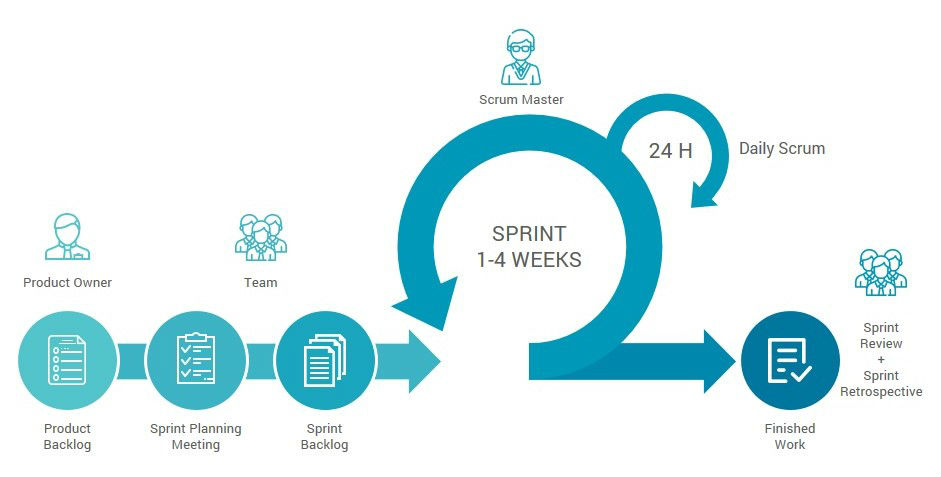Every «hype» thing or event has a certain regularity: the more people talk about it, the less they really know about it. Scrum is not an exception. You may find hundreds of relevant articles and IT news, where it may seem that there is only one best Agile methodology and this is Scrum. A large Agile family contains various powerful methodologies and Scrum is not the sole system of implementing Agile principles. However, this methodology is still actively used all over the world.
People go mad about Scrum: many IT blogs write about it, many practical courses promise to teach all Scrum features, many companies want to see a working experience with Scrum in CVs, and so on. Scrum conquers them all. In this post, we define why.

Scrum is a popular approach for achieving software agility. This is a method of iterative and incremental product delivery that implicates collaborative decision-making and frequent feedback.
A Scrum process consists of short sprints. The methodology allows product teams to respond rapidly to changes within product management. The main idea is to break large projects into smaller stages, reviewing and adapting them along the way. At the very end of the project, Scrum ensures that the most valuable work has been completed.
Scrum seriously contrasts with some other approaches, for example, with traditional Waterfall, that requires analysis, extensive creation of requirements, and design documentation before developing.
According to statistics, the overall success rate of projects delivered with the help of Scrum is 62%.
The term «Scrum» is known from 1986. There was an article in Harvard Business Review by Hirotaka Takeuchi and Ikujiro Nonaka. The authors made an analogy comparing high-performing, cross-functional teams to the Scrum formation used by rugby teams.

This metaphor related to rugby inspired them to perfectly described the benefits of self-organizing teams in product development.
The next “chain elements” that moved this creative idea from the paper to the software development sphere were Jeff Sutherland, Ken Schwaber, and Mike Beedle. They titled the new method as Scrum (in rugby, this term describes how teams form a circle to go for a ball and get it back into a play).
The Scrum methodology requires the participation of three canonical roles. These Scrum “Who” are:
A Scrum Master keeps the whole process, act as an advocate for the team and protect it. This is a key person who facilitates team communication, removes potential obstacles, arrange all discussions and negotiates with “the external world”. The Scrum master job is typically a full-time position that not include business trips. The main responsibility of this person is to always care about the team and product functionality.
Scrum Masters are highly paid role. According to the latest statistics, their professional experience plays a key role in their earnings.

Actually, returning to the current popularity of Scrum, let's remind some more interesting facts, provided by The 2019 Scrum Master Trends Report published by Scrum.org:
A Product Owner (PO) represents the voice of a customer. This person is empowered to make global decisions about the product, maintain a product backlog, define and prioritize all backlog items. He/she also communicates the product vision to the team. Product Owners work in cooperation with their team on a daily basis.
The PO is usually accountable for providing a real business goal of the project. He/she assists employees to clearly understand the main idea of the project and cares about financial success.
Teams typically involve 6-8 people responsible for product delivery. These specialists make task commitments and estimates, participate in daily Scrum meetings and report their statuses.
At first sight, the Scrum methodology requires few artifacts but instead, it clearly concentrates on delivering software that produces business value.
Here’re these artifacts in brief intro:

The Scrum methodology is closely related to special ceremonies and meetings. Sprint planning meetings, daily standups, the Sprint review, and the retrospective are the required Scrum events. A release planning meeting can be optional.
A sprint planning meeting is held on the first day of every Sprint. It requires the participation of all the roles. Here's how it goes:
After the Sprint planning, the team begins to track the progress of tasks. Here you can not do without reliable and convenient task boards.
The boards assist in tracking the progress of tasks for each feature. The simple columns such as To Do, Doing, and are really helpful. A daily Scrum meeting can be also easy appointed on such a board.
Here are some examples of Scrum boards. In Trello:

and in Hygger:

The meeting is aimed to invite stakeholders to make a review at the end of the sprint. They review all the features that were completed and request feedback.
The PO tracks all feedback details and incorporates them into the product backlog if needed. The team conducts a retrospective that determines what was done well, what they struggled with or what improvements are needed.
This event is aimed to do long-term planning for multiple sprints. Release planning meetings are typically done quarterly. They also require the participation of all team members.
The Product Owner presents the features to be completed in the following quarter. Such planning can be feature-driven, cost-driven or time-driven.
Now, when everything is laid it out and there is a general understanding of the Scrum methodology, it is worth to define why it is still popular in 2019 and it's gaining the attention of many teams and projects.
Nothing scared. Just easy steps and clear functionality. Here's how it can be visualized with the help of Hygger.io:
The platform proposes a wide toolkit for working with Scrum. First of all, you are able to create a simple Sprint board.

Then you fill a working board with tasks, evaluate them and launch the first Sprint. You'll have several options for evaluation – both in Story Points and in hours to run Sprint planning.
You are also free to log working time. Once all necessary estimations are done, you may start a new Sprint.

The Sprint progress can be controlled with the Burndown chart. Next, you can analyze the results after releasing the sprint. In Sprint boards you'll also find a historical summary of all sprints that were released on it. Choose the History section of the board menu.
Looks easy, right?
In order to get the best understanding of how the work flows with Scrum, try to read more about the methodology, watch available video tutorials form famous Scrum coaches and study useful Scrum guides and learning centers. You should track everything that happens closely and note all specific moments in the work with Scrum. Improving professional Scrum education and getting Scrum certification is also a great idea.
Today Scrum is a popular Agile framework that helps to deliver valued products iteratively, continually inspecting and adapting the process.
Hopefully, our quick overview of Scrum was helpful and you got the real inspiration to apply it in project management.
Feel free to learn about other methodologies to compare, leave your feedback in comments and succeed in Scrum!
People go mad about Scrum: many IT blogs write about it, many practical courses promise to teach all Scrum features, many companies want to see a working experience with Scrum in CVs, and so on. Scrum conquers them all. In this post, we define why.

Scrum project management for beginners
Scrum is a popular approach for achieving software agility. This is a method of iterative and incremental product delivery that implicates collaborative decision-making and frequent feedback.
A Scrum process consists of short sprints. The methodology allows product teams to respond rapidly to changes within product management. The main idea is to break large projects into smaller stages, reviewing and adapting them along the way. At the very end of the project, Scrum ensures that the most valuable work has been completed.
Scrum seriously contrasts with some other approaches, for example, with traditional Waterfall, that requires analysis, extensive creation of requirements, and design documentation before developing.
According to statistics, the overall success rate of projects delivered with the help of Scrum is 62%.
The term «Scrum» is known from 1986. There was an article in Harvard Business Review by Hirotaka Takeuchi and Ikujiro Nonaka. The authors made an analogy comparing high-performing, cross-functional teams to the Scrum formation used by rugby teams.

This metaphor related to rugby inspired them to perfectly described the benefits of self-organizing teams in product development.
The next “chain elements” that moved this creative idea from the paper to the software development sphere were Jeff Sutherland, Ken Schwaber, and Mike Beedle. They titled the new method as Scrum (in rugby, this term describes how teams form a circle to go for a ball and get it back into a play).
What are the key roles in Scrum methodology?
The Scrum methodology requires the participation of three canonical roles. These Scrum “Who” are:
- Scrum Master
- Product Owner
- Team
A Scrum Master keeps the whole process, act as an advocate for the team and protect it. This is a key person who facilitates team communication, removes potential obstacles, arrange all discussions and negotiates with “the external world”. The Scrum master job is typically a full-time position that not include business trips. The main responsibility of this person is to always care about the team and product functionality.
Scrum Masters are highly paid role. According to the latest statistics, their professional experience plays a key role in their earnings.

Actually, returning to the current popularity of Scrum, let's remind some more interesting facts, provided by The 2019 Scrum Master Trends Report published by Scrum.org:
- Scrum Masters with formal Agile certifications have higher salaries than specialists without it.
- 81% are using Scrum with other Agile practices (Kanban, XP or DevOps).
- Female salaries in Scrum are higher than their male counterparts' salaries.
What are the core duties of Scrum Masters?
- Manage all Scrum process
- Coordinate them with the team
- Improve the efficiency of the development team
- Remove impediments
- Schedule daily meetings, decision-making processes, demos, and retrospective meetings
- Help the PO to maintain the product backlog in a good shape
A Product Owner (PO) represents the voice of a customer. This person is empowered to make global decisions about the product, maintain a product backlog, define and prioritize all backlog items. He/she also communicates the product vision to the team. Product Owners work in cooperation with their team on a daily basis.
The PO is usually accountable for providing a real business goal of the project. He/she assists employees to clearly understand the main idea of the project and cares about financial success.
What are the key duties of Product Owners?
- Turn a project into a successful business product to satisfy customers' needs and wishes, to meet their tastes and be in demand in the market
- Develop a high-quality working plan, that will be approved with the customer and the Scrum Master
- Prioritize tasks from the requirement list, define the most relevant features and provide all necessary resources for their implementation
- Inspect and accept working progress reports received from Scrum Master
- Work on project budgeting
Teams typically involve 6-8 people responsible for product delivery. These specialists make task commitments and estimates, participate in daily Scrum meetings and report their statuses.
Introducing to the key Scrum methodology artifacts
At first sight, the Scrum methodology requires few artifacts but instead, it clearly concentrates on delivering software that produces business value.
Here’re these artifacts in brief intro:
- A product backlog is a complete set of the functionality that remains to be added to the product. It is usually prioritized by the Product Owner.
- Backlog grooming sessions that are also managed by the PO. These sessions are aimed to allow the team to work on the most valuable features first.
- A sprint backlog is a prioritized list of tasks the team needs to complete within a Sprint.
- A burndown chart, which shows the amount of work remaining in a Sprint. It provides an effective way to determine whether a Sprint is on schedule to have all planned issues finished.

Scrum ceremonies
The Scrum methodology is closely related to special ceremonies and meetings. Sprint planning meetings, daily standups, the Sprint review, and the retrospective are the required Scrum events. A release planning meeting can be optional.
What is Sprint planning?
A sprint planning meeting is held on the first day of every Sprint. It requires the participation of all the roles. Here's how it goes:
- A Product Owner presents the features to be completed in a Sprint.
- The team identifies the tasks to implement these features.
- All participants review estimates to see if there is a time to complete all the features requested.
- The team commits to the Sprint.
- If not, the low-priority features go back into the backlog.
What is tracking progress?
After the Sprint planning, the team begins to track the progress of tasks. Here you can not do without reliable and convenient task boards.
The boards assist in tracking the progress of tasks for each feature. The simple columns such as To Do, Doing, and are really helpful. A daily Scrum meeting can be also easy appointed on such a board.
Here are some examples of Scrum boards. In Trello:

and in Hygger:

What is a sprint review?
The meeting is aimed to invite stakeholders to make a review at the end of the sprint. They review all the features that were completed and request feedback.
The PO tracks all feedback details and incorporates them into the product backlog if needed. The team conducts a retrospective that determines what was done well, what they struggled with or what improvements are needed.
What is release planning?
This event is aimed to do long-term planning for multiple sprints. Release planning meetings are typically done quarterly. They also require the participation of all team members.
The Product Owner presents the features to be completed in the following quarter. Such planning can be feature-driven, cost-driven or time-driven.
Now, when everything is laid it out and there is a general understanding of the Scrum methodology, it is worth to define why it is still popular in 2019 and it's gaining the attention of many teams and projects.
5 strong reasons to choose Scrum methodology in 2019
- Scrum is rather simple. It includes not many artifacts and teams quickly realize the benefits from it.
- The center of the development process in Scrum is a customer, that makes the methodology one of the most customer-focused.
- Scrum team members work closely together towards a common goal, so their internal relations are transparent and based on trust.
- The method allows teams to feel more flexible to evolve business goals and altering requirements. Scrum teams can react as quickly as possible.
- Scrum is a transparent process that engages all stakeholders. This transparency is permanently improved thanks to daily meetings by discussing progress, planning adjustments, and delivering feedback.
How to run Scrum with a powerful project management tool?
Nothing scared. Just easy steps and clear functionality. Here's how it can be visualized with the help of Hygger.io:
The platform proposes a wide toolkit for working with Scrum. First of all, you are able to create a simple Sprint board.

Then you fill a working board with tasks, evaluate them and launch the first Sprint. You'll have several options for evaluation – both in Story Points and in hours to run Sprint planning.
You are also free to log working time. Once all necessary estimations are done, you may start a new Sprint.

The Sprint progress can be controlled with the Burndown chart. Next, you can analyze the results after releasing the sprint. In Sprint boards you'll also find a historical summary of all sprints that were released on it. Choose the History section of the board menu.
Looks easy, right?
Final thoughts
In order to get the best understanding of how the work flows with Scrum, try to read more about the methodology, watch available video tutorials form famous Scrum coaches and study useful Scrum guides and learning centers. You should track everything that happens closely and note all specific moments in the work with Scrum. Improving professional Scrum education and getting Scrum certification is also a great idea.
Today Scrum is a popular Agile framework that helps to deliver valued products iteratively, continually inspecting and adapting the process.
Hopefully, our quick overview of Scrum was helpful and you got the real inspiration to apply it in project management.
Feel free to learn about other methodologies to compare, leave your feedback in comments and succeed in Scrum!